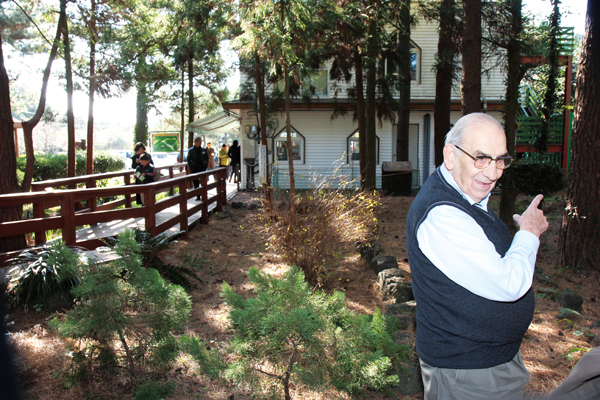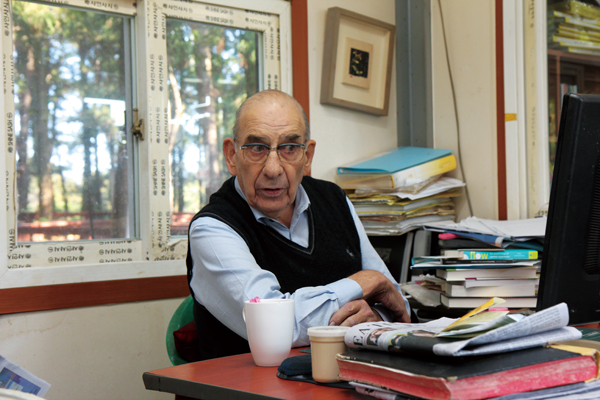 
▲ Photo by Todd Thacker
http://www.jejuweekly.com/news/articleView.html?idxno=2345
제주 영자 신문사 Jejuweekly에
김녕미로공원 설립자이신 더스틴교수님 인터뷰기사가 실렸습니다.
더스틴 교수님께서 한국에 오시게 된 배경과 미로공원을 만드시게 된
동기에 대해 그 어떤 자료보다도 정확하게 기술을 해 주셨네요.
... 애정어린 눈길로 더스틴교수님에 대해
담백하고 정확한 기사를 써 주신
Jejuweekly의 Angela Kim 기자님께 감사를 드립니다.^^
참,
미로공원을 응원해주시는 모든 분들께 새해 인사 드립니다.
새해 복 많이 받으세요.^^
The man in the maze
Meet Fred Dustin, a man with decades of experience in local academia, government, and business
Friday, January 20, 2012, 11:58:07 Angela Kim angelakim@jejuweekly.com
Those of you who lived in Korea in 2000 may remember a mobile phone TV commercial featuring Lee Young Ae, a famous Korean television star, in a white dress running through a maze decorated with silver bells. That maze was Jeju’s expat-owned Kimnyung Maze Park.
In 1983, for the first time in Northeast Asia, a man came up with the idea of constructing a maze. In 1995, after 12 years of preparation, Kimnyung Maze Park officially opened to the public.
After 16 years of operation, this maze has become one of the most popular destinations on Jeju. The Jeju Weekly spoke with its founder Professor Frederic Dustin.
There are many titles attached to Frederic Dustin: Kimnyung Maze Park director, professor, philanthropist, honorary Jeju citizen, winner of the Jeju Culture Prize, and maybe an honorary grandfather for many here.
In March of 1952, he came to Korea for the first time as a young American soldier for a year and fought in the Korean War. Seven years later, he returned to Korea and worked in various fields, ranging from the mining industry to journalism to the poultry industry. From 1968 to 1971, he also worked as a supply officer for the 19th General Support Group of the US Army. While working in Seoul, he would come down to Jeju often, and fell in love with the island. As an entrepreneur, he acquired the land surrounding Manjang Cave, Jeju City, in 1963.
In 1971, he moved to Jeju permanently with his wife who was suffering from cancer.
When asked “Why Jeju?” Dustin offered a simple and clear answer. “We wanted to get out of Seoul.” His wife who was a Lutheran missionary born in China wanted to stay in Asia to write.
His life on Jeju had begun. He put up a tent on his land and lived a simple life with his wife. He spent most days sitting on his porch and walking around the island.
“Me and my friend used to sit and stare at the land, thinking ‘what can I do with the land?’” said Dustin.
One day in 1983, he coincidentally encountered an article on Adrian Fisher and his maze designs, and he knew what he needed to do: He decided to build a maze. He asked Fisher, one of the most well-known maze designers at that time, to help and the answer was yes. The professor and Fisher dedicated almost three years to designing the maze in a way that it would symbolize Jeju. For example, the perimeter of the maze resembles the coastline of the island.
On Nov. 19, 1987, he planted the first evergreen Leyland Cypress tree (Cupressocyparis leylandii). He remembers questioning then whether or not the tree would grow, but “in fact, it did well,” and by 1995, Dustin had a fortress of trees, all taller than most people.
Some might wonder why he is called “Professor Dustin.” Starting in 1955 he began lecturing at Yonsei University, and over the years, he has taught English at ChungAng, Hongik, and Sejong universities in Seoul.
In September 1971, four months after he relocated to the island for good, he was a guest professor at Jeju College, which is now Jeju National University (JNU). He taught English to Jeju students for 23 years, until he went to work for the provincial government in 1995.
“I loved teaching. I never got tired of teaching,” he said.
His affection for the university is apparent through his annual donations to JNU. Last year, he donated about 100 million won to JNU and the college for seniors, which accounts for a little over 8 percent of the maze park’s gross income. With the primary recipient being the field of education, his donation goal is 15 percent of the maze park’s net profits.
However, living on Jeju as a foreigner was not always easy. On the last day of 1994, he was pushed into retirement from JNU and consequently had to leave Korea due to his visa status. He went to Arizona to look for a place to stay after retiring.
However, on March 15, the professor received a surprising telephone call from the Korean embassy in Washington D.C.
“Governor Shin Gu Bum at that time had offered me a job to work for the [Jeju] provincial government … I had tears in my eyes,” said the professor.
Over the course of the 30 years he has lived on Jeju, he overcame various obstacles and created the maze park as a “very small, modest family oriented business,” which hires locals. This year, Kimnyung Maze Park is expecting about 450,000 visitors, with the company charging 3,000 won per person, yet the professor is determined to give even more back to the Jeju society.
He believes that the park has a bright future and emphasized that it will neither be expanded nor converted into a theme park.
Due to Dustin’s efforts, he has popularized mazes as tourist attractions among Koreans. Today, there are 14 attractions that can be classified as mazes, on Jeju alone.
“We have to be more resourceful in studying what we need to do to make ourselves more visible to more people. We have to look at it from a competition point of view and we have to be competitive,” he suggested to those who work in the Jeju tourism industry.
To learn more about Kimnyung Maze Park, go to www.Jejumaze.com.
|








